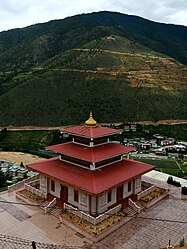Hinduism in Bhutan
 | |
| Total population | |
|---|---|
| 190,000 (2011) 22.6% of total population | |
| Religions | |
| Hinduism |
| Hinduism by country |
|---|
  |
| Full list |
Hinduism is the second largest religious affiliation in Bhutan, covering about 22.6% of the population, according to the Pew Research Center 2010.[1] It is followed mainly by the ethnic Lhotshampa.[2] The Shaivite, Vaishnavite, Shakta, Ganapathi, Puranic, and Vedic schools are represented among Hindus. Hindu temples exist in southern Bhutan, and Hindus practice their religion in small- to medium-sized groups.[3] About 75% of the population of Bhutan are Buddhist.[4]
History
Festival
The main festival of Bhutanese Hindus is Dashain.[5] It is the only recognized Hindu public holiday in Bhutan. It was recognized as a holiday in 2015 by the King of Bhutan.[6] He also celebrated Dashain with Hindus that year.[7][8] The first nine days of Dashain symbolize the battle which took place between the different manifestations of Durga and Mahishasura. The tenth day is the day when Durga finally defeated him. For other Hindus, this festival symbolizes the victory of Ram over Ravan as recounted in the Ramayana.[9] They also prepare Sel roti during Dashain.
Hindu Dharma Samudaya
The Hindu Dharma Samudaya of Bhutan (HDSB) is the Hindu religious organization, established in 2009. It is registered with the Chhoedey Lhentshog, the Commission for Religious Organizations of Bhutan. HDSB is dedicated to promote spiritual traditions and practices of Sanathan Dharma in Bhutan so to foster and strengthen human values. Its head office in the capital city, Thimphu, the organization is managed by a Board of Directors of volunteers comprising representatives from Hindu priests and other HDSB members who are elected at an annual general meeting.[10]
Persecution of Hindus
Ethnic cleansing
Ethnic cleansing of Lhotshampa Hindus was carried out by King Jigme Singye Wangchuk of Bhutan during the 1990s.[11] In the early 1990s, several thousands of Bhutanese residents in southern Bhutan were ethnically cleansed by the authorities under the provisions of the amended Citizenship Act of 1985, because they followed the Hindu religion and culture, and had mixed Himalayan ethnicity, with one parent of Nepali origin. Nepal, like India, shares common Hindu and Buddhist traditions, but the majority of Bhutan's population is exclusively Buddhist and the royal family has demonstrably shown a pronounced bias against its Hindu citizens who have been settled there for centuries.[12]
Refugees and diaspora
After the purge of the 1990s began, Bhutanese Hindus were forced to live in refugee camps set up by the UN High Commission for Refugees United Nations High Commissioner for Refugees (UNHCR) in eastern Nepal in 1992.[13] With help of UNHCR and WHO, the majority of Bhutanese refugees are resettled to the United States, Canada, Australia, and European countries. There is a small number of refugees living in camps in Nepal still hoping to see their motherland for more than 30 years.[14]
Discrimination
The government provided financial assistance for the construction of Buddhist temples and shrines and state funding for monks and monasteries.[2] NGOs alleged that the government rarely granted permission to build Hindu temples; the last report of such construction was in the early 1990s, when the government authorized the construction and renovation of Hindu temples and centers of Sanskrit and Hindu learning and provided state funds to help finance the projects.[15] The government argued that it was a matter of supply and demand, with demand for Buddhist temples far exceeding that for Hindu temples. The Government stated that it supported numerous Hindu temples in the south, where most Hindus reside, and provided some scholarships for Hindus to study Sanskrit in India.
See also
- Bhairabkunda Shiva Mandir, Bhutan
- Freedom of religion in Bhutan
- Hinduism in Southeast Asia
- Religion in Bhutan
References
- ^ "Religion in Bhutan - Freedom of Religion and Bhutanese Culture". www.holidify.com. Retrieved 7 June 2021.
- ^ a b "Bhutan". United States Department of State. Retrieved 7 June 2021.
- ^ Basnet, Tika Ram (30 April 2020). "Hinduism and the Caste System in Bhutan". Rochester, NY. SSRN 3295446.
{{cite journal}}: Cite journal requires|journal=(help) - ^ "Global religion Table" (PDF). Pew Research Centre.
{{cite web}}: CS1 maint: url-status (link) - ^ "16 Dashain Festival in Nepal ideas | nepal, festival, path to heaven". Pinterest. Retrieved 7 June 2021.
- ^ "Bhutan king celebrates Dashain festival, prays at Goddess Durga temple". www.indiafaith.in. Retrieved 7 June 2021.
- ^ "His Majesty celebrates Dashain with the people of Loggchina". BBS. 23 October 2015. Retrieved 7 June 2021.
- ^ "Hinduism Today - Authentic resources for a billion-strong religion in renaissance". Hinduism Today. Retrieved 7 June 2021.
{{cite web}}: CS1 maint: url-status (link) - ^ "Dashain Festival - Nepal's Biggest, Longest and Most Auspicious Festival". Tibet Travel and Tours - Tibet Vista. Retrieved 7 June 2021.
- ^ "Bhutan Hindu Dharma". Retrieved 7 June 2021.
{{cite web}}: CS1 maint: url-status (link) - ^ "The ethnic cleansing hidden behind Bhutan's happy face-World News , Firstpost". Firstpost. 1 July 2013. Retrieved 7 June 2021.
- ^ "Bhutanese Refugees". Bhutanese Refugees. Retrieved 7 June 2021.
- ^ "Bhutan's Dark Secret: The Lhotshampa Expulsion". thediplomat.com. Retrieved 7 June 2021.
- ^ "Bhutanese Refugees in Nepal". U.S. Department of State. Retrieved 7 June 2021.
- ^ Bhattacherjee, Kallol (3 February 2019). "Buddhism gives firmer ground for India-Bhutan relations". The Hindu. ISSN 0971-751X. Retrieved 7 June 2021.
External links
 Media related to Hinduism in Bhutan at Wikimedia Commons
Media related to Hinduism in Bhutan at Wikimedia Commons
